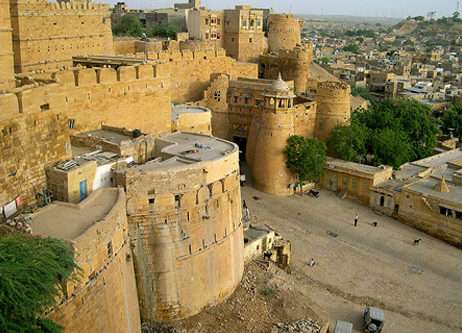Jaisalmer Fort: Historical
Known for its remarkable past, Jaisalmer Fort has seen numerous conflicts with the Mughals, Tughlaqs, Khiljis, and Rathore Kings. Raja Rawal Jaisal constructed the fort in the year 1156. After two attacks by the Sultan of Delhi, Alauddin Khilji, a fortified defense building known as Rang Burj was however erected to it in 1276 AD by Rawal Jethsi.
The fort was surrounded by Sultan Alauddin Khilji’s forces for roughly 8 to 9 years. In 1294, the Sultan finally defeated the Bhati Rajputs and took control of Jaisalmer Fort. This compelled some 25,000 women to self-immolate or perform jauhar in order to save their honor.
Khilji’s forces left the fort after retaining control of it for roughly two years. Later, the remaining Bhatis moved back in, and the kingdom gradually reclaimed its former splendor.
When Delhi’s Sultan Firoz Shah Tughlaq besieged Jaisalmer in the late 14th century, the fort saw another jauhar.
During Rawal Lunakaran’s rule in 1541, Humayun launched another assault on Jaisalmer Fort. When Akbar, the son and heir of Humayun, demanded his daughter’s hand in marriage, Rawal was compelled to comply. The British East India Company signed a pact with Maharawal Mulraj, who subsequently assumed possession of the fort after it was abandoned by the Mughal emperors in 1762. As a result, Jaisalmer became one of Rajasthan’s most significant princely states. However, after India gained its independence, the city formally joined the Union of India.
This enormous fort had formerly housed the whole Jaisalmer population at one point. Up until the British invasion, it was a significant trading and commercial hub.
Fort Jaisalmer:Today
Many descendants of Rajput and Brahmin families still reside in Jaisalmer Fort, the only living fort in India. The fort is a popular tourist destination in Jaisalmer even though it is no longer a significant military outpost or commercial hub. Additionally, in 2013 it received UNESCO World Heritage Site status.
Visitors can hire a local guide or buy entry tickets and tour the fort independently. There are also audio tours available next to the ticket window. Along with enjoying the fort’s architecture, you should also check out the Fort Palace Museum, Jain Temples, Havelis, and other sights.
Fort Jaisalmer: Architecture
The Jaisalmer Fort, a stunning fusion of Rajput and Mughal building styles, is a work of architectural wonder. This fort, which is 1500 feet long and 750 feet broad, is surrounded by several yellow sandstone palaces, homes, temples, wells, havelis, and other buildings. The fort is beautiful at all times of the day; during the day, it sparkles in the sunlight with a glittering golden hue, and at dusk, it takes on a honey-gold hue. The fort’s main attractions are:
Jain and Hindu temples, as well as exquisitely carved havelis. The Jain temples are embellished with numerous mirrors, carvings, and paintings and feature the well-known Dilwara temple architectural style.
The magnificent craftsmanship and beauty of Dussehra Chowk, a large courtyard
The Patwon Ki Haveli’s beautiful stone sculptures, mural paintings, and jalis, which are situated just beyond the old fortification
The majestic splendor of Jaisalmer Fort is enhanced by its setting atop Trikuta Hill, 250 feet above the nearby town, which makes it a must-see tourist destination. You can also enjoy the breathtaking views of the town from Dussehra Chowk and other areas of the fort when you are up there.
Activities to do and see
Raj Mahal or Maharwal Palace’s marble throne and several antiques
The Maharwal Palace’s opposite, five-story Tazia Tower
The magnificent architecture and design of the fort’s palaces, include Jawahar Palace, Sarvottam Vilas, Zenana Mahal, Gaj Mahal, Bada Vilas, and Moti Mahal
The two magnificent halls, Diwan-i-Am and Diwan-i-Khas, are used for public and private audiences, respectively.
The Laxminath Temple honors Vishnu and Lakshmi, two Hindu deities.
The Parsvanatha Temple, Chandraprabha Temple, Sitalanath Temple, Sambhavanath Temple, Santinath and Kunthunath Temple, and Rishabhanath Temple are the seven Jain temples that were constructed between the 12th and 16th centuries.
Gyan Bhandar, a library in the Jain temple complex housing 600 idols, is the largest of the 600-idol Sambhavanatha Jain Temple.
Restaurants serving delicious regional specialties at Dussehra Chowk.Local stores provide wall hangings, camel leather bags, lahariya sarees, patchwork bedspreads with eye-catching patterns, Rajasthani clothes and accessories, ethnic silver jewelry, and more.
sloping lanes inside the fort the rooftop view of the fort’s environs in all directions
Unknown information about the Jaisalmer Fort
Three tiers of walls were built within the fort for improved defense against intruders. Stone formed up the outermost layer.
Of the 99 bastions in the Jaisalmer fort, 92 were constructed between 1633 and 1647.
About one-fourth of the town’s residents live in the fort.
Water is still routinely available from the Jaisalmer Fort wells.
During Dussehra, a large fair is held here, and the king also attends.

